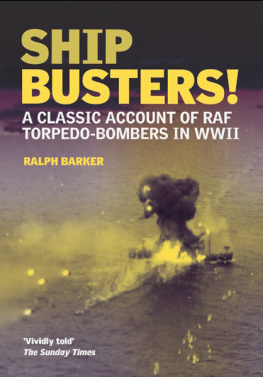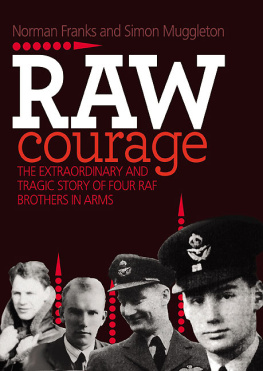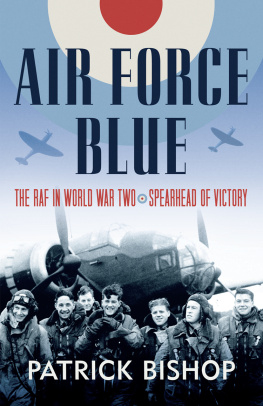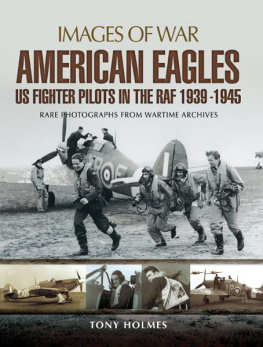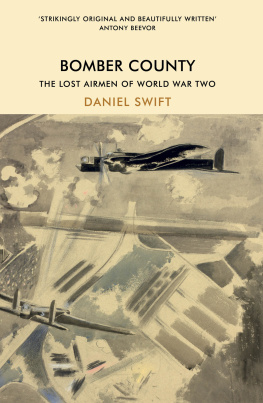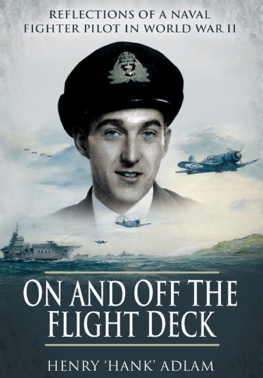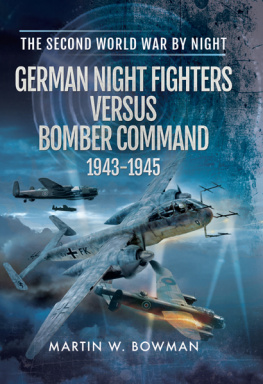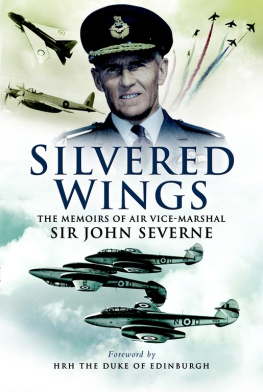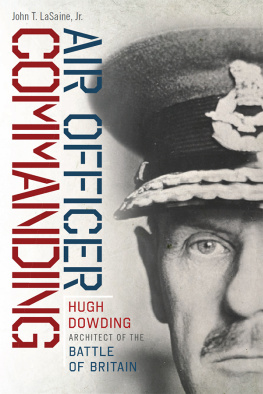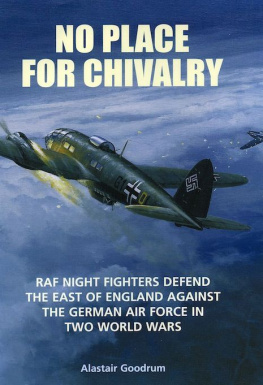

Published by
Grub Street
4 Rainham Close
London
SW11 6SS
Copyright 2005 Grub Street
Text copyright 2005 Alastair Goodrum
British Library Cataloguing in Publication Data
Goodrum, Alastair
No place for chivalry : RAF night fighters defend the East
of England against the German air force in two world wars
1. Great Britain. Royal Air Force History 1939-1945
2. World War, 1939-1945 Aerial operations, British
3. Air defences Great Britain History 20th century
4. Night fighting (Military science) 5. Night fighter planes
I. Title
940.544941
ISBN 1 904943 22 5
ePUB ISBN: 9781909166530
PRC ISBN: 9781904943228
All rights reserved. No part of this publication may be reproduced,
stored in a retrieval system, or transmitted in any form or by any
means, electronic, mechanical, photocopying, recording, or otherwise,
without the prior permission of the copyright owner.
Typeset by Pearl Graphics, Hemel Hempstead
Printed and bound by Biddles, Kings Lynn
Contents
In memory of Jack and Mike
... night fighter pilots are individualists who do not want very much0to be disciplined. For them night is more free than day,
free space for the expression of a feud. They find raiders in the moon
above low cloud, as shadows in the flare of ack-ack and searchlight
and above the flickering glare of ground fires.
H E Bates
Acknowledgements
I would like to thank Ian Blackamore and Dave Stubley of the Lincolnshire Aircraft Recovery Group, Bill Welbourne of the Fenland and West Norfolk Aircraft Preservation Society, Nick Squires of 23 Squadron, Peter Montgomery and Simon Parry, all of whom have provided details that have enhanced the technical and human interest elements of a number of the incidents mentioned. I am grateful to C R Salewski MA, archivist of the Deutches Museum fur Luftschiffahrt und Marinefliegerei in Nordholz, Germany, for information and illustrations relating to WW1 Naval Zeppelin operations. Illustrations have come from many sources but I appreciate particular help received from Roy Bonser, Alec Brew, Peter Brooks, Robin Duke-Woolley, Ron Durand, Ken Ellis, Chris Goss, Peter Green, Mike Kelsey, Simon Parry, Winston Ramsey, Wilhelm Ratuszynski and E A Walker. However, the original ownership of some photographs remains obscure or has been unable to be established and I apologise for any credit omitted for this reason. Extracts from official documents appear by permission of the Controller HMSO and Crown copyright is acknowledged. Quotes from Bill Normans article in the December 2000 issue of Flypast are reproduced by permission of Key Publishing Ltd. Finally I am most grateful to John Davies and Louise Stanley of Grub Street, for giving me the opportunity to bring my project to life.
Authors note: Some combat reports consulted have been found to state range distances in yards while others have expressed them in feet. Although range measurements in feet appear in many reports where AI interceptions are involved, this practice is only evident in such reports from 1942 onwards. In the interests of consistency, in the narrative of this book range distances have been expressed in yards.
CHAPTER 1
Dangerous Moonlight
Peering through the cockpit canopy of a Junkers Ju88, Luftwaffe Unteroffizier Heinrich Beul shifted uneasily, gripped his MG15 machine gun more tightly and tried to scan the blackness of the night sky with his eyes. Peering intently at two flickering cathode-ray tubes, Pilot Officer Yeomans, Royal Air Force, seated in the rear cockpit of a Beaufighter, was piercing that same blackness with his airborne radar. On a midsummer night in 1941 each had a scent of the other; each one was seeking a kill.
In World War 2 the counties of Lincolnshire, Norfolk and Cambridgeshire, clustered round The Wash, were littered with airfields that made juicy targets for Luftwaffe raiders. For the Luftwaffe, the night fighter unit that evolved into Nachtjagdgeschwader 2 (NJG2) bore the brunt of the first phase of intruder missions that lasted until late 1941, scoring a considerable measure of success against operational units, while also disrupting the flying training programme on the RAFs home territory. Furthermore, when the Luftwaffes daylight offensive in the south and east of England was finally broken, its attention turned to mounting a night bombing blitz across the United Kingdom that increased its intensity from September 1940. Thus, in addition to being an arena for night fighter versus intruder encounters, this three-dimensional corridor into the heart of England also became an aerial crossroads for elements of the German night bombing offensive directed, for example, against the industrial Midlands and North. It soon became apparent that the watery expanse of The Wash, pointing like a signpost to the heart of England, together with its sparsely populated fenlands, was a one hundred-mile passageway through which the Luftwaffe expected to fly with little interference into the industrial heartland and indeed beyond. No doubt this same philosophy also appealed to RAF Bomber Command planners when they plotted routes into the German homeland across the Zuider Zee in Holland. Both combatants found, to their cost, that what began as a quiet back-door route became, instead, a killing ground for the night fighters of RAF Wittering and Digby Sectors.
A clue to the Luftwaffes intentions was first discovered in the form of a navigational radio beam, oriented from east to west near Spalding, by the Wireless Intelligence Development Unit (WIDU), a special signals flight commanded by Sqn Ldr R Blucke, based at RAF Wyton on the southern edge of the region. Documents recovered from downed enemy aircraft, together with intercepted radio traffic, suggested the existence of such beams and WIDU was hastily established to conduct a detailed search of the airwaves. Equipped with radio receivers capable of monitoring signals around the 30-33 megacycle wavelength, the unit had three Avro Ansons to carry the sets and a team of specialist wireless operators to do the job. Success came quickly, for on June 21 1940, after only a handful of sorties, Anson pilot Flt Lt Hal Bufton and his Y-service radio operator Corporal Dennis Mackey located signals with the dot, dash and continuous tone characteristics of the German Lorenz blind-landing system, passing east/west one mile south of Spalding. Following the beam allowed them to detect a second beam intersecting the first at Beeston right on track for the Rolls-Royce aero-engine factories in Derby! Later it was established that the first beam was being transmitted from Kleves on the Dutch border, while the second was believed to have originated in Bredstedt on the German-Danish border. Together they were part of a German air radio-navigation system used to guide bombers to their targets that became known by the code name Knickebein (Crooked Leg). The subsequent electronics war is the fascinating in-depth subject of several books and it is not intended to re-examine it here.
This, then, was the stage on which the battle for control of the English night sky in World War 2 was acted out. Now well take a look at some of the players in this deadly game in their various guises, to show what happened when the hunter got to grips with the hunted.
Air cover against possible night bombing raids was spread thinly in the Midland region at the beginning of 1940 and it seemed as if the lessons of the last war had been forgotten. In order to appreciate how events unfold in this story, yet avoid becoming bogged down with the complexity of trying to follow operations by all the night fighter squadrons throughout the whole of the UK, the exploits of one unit 23 Squadron will be taken as representative of this particular period of the night air war. Night fighter squadrons, in the area of the country covered by this narrative, came under the control of 12 Group of Fighter Command, whose patch stretched across the heartland of England from The Wash to the Mersey and York to Birmingham. 23 Squadron was in RAF Wittering Sector.
Next page

